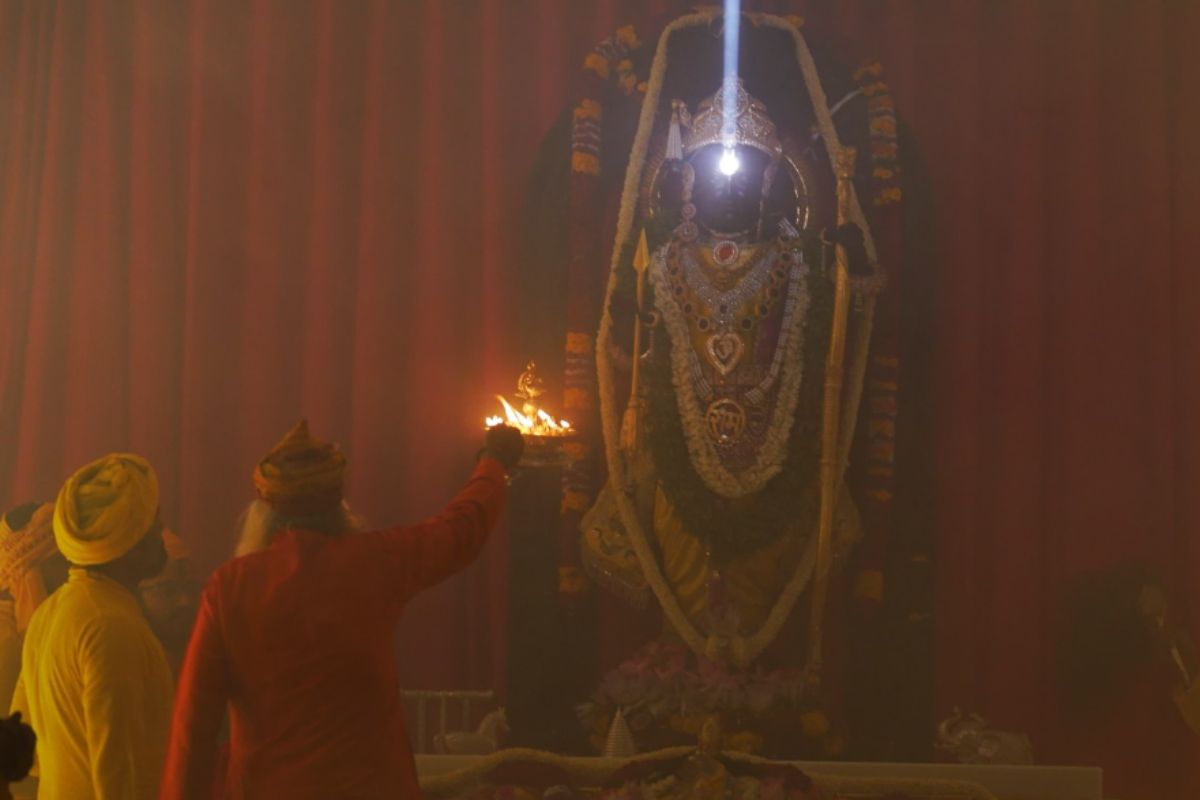Devotees witness ‘Surya Tilak’ of Ram Lalla in Ayodhya in lakhs
Over 5 lakh devotees from across the country and even from abroad thronged the Ram Janmabhoomi to celebrate the Ram Janmotsav at the Ram Temple.
Over five lakh devotees from across the country and from abroad thronged the Ram Janmabhoomi on the historic occasion when the Ram Janmotsav was celebrated for the first time at the grand Ram Temple after 500 years.

Photo: X/@ShriRamTeerth
Ram Lalla’s birth anniversary was celebrated at his birthplace here on Wednesday on the occasion of Ram Navami with the Surya Abhishek (purification by sun rays) of his idol exactly at noon.
Over 5 lakh devotees from across the country and even from abroad thronged the Ram Janmabhoomi to celebrate the Ram Janmotsav at the Ram Temple.
On the occasion, the entire Ayodhya resonated with the chant of “Jai Shree Ram”, particularly when the devotees reached Ram Lalla for his darshan (a glimpse).
Advertisement
There was a lot of enthusiasm and excitement about the celebration of the first birth anniversary of the deity in the grand temple built after 500 years. There was a long queue of devotees in the court of Ram Lalla since 3:30 am. Arrangements had been made by the temple trust and the administration for facilitate the devotees to take part in the rituals.
The process of celebrations started at noon with rituals amid chant of mantras. Before this, Ram Lalla was groomed for the occasion adorning with jewellery.
The Surya Abhishek took place at 12.01 pm when the sun’s rays fell directly on the face Ram Lalla’s face forming a tilak of about 75 mm at the centre of his forehead and continued till 12.06 am, for a full 5 minutes. This was the result of a combination of religion and science for which scientists worked for months while many trials were conducted around this.
Ram Temple Trust General Secretary Champat Rai claimed that scientists have studied the movement of the Sun over Ayodhya. After determining the exact direction, reflectors and lenses were installed on the upper floor of the temple. The sun’s rays were rotated to reach the forehead of the deity. First, the sun rays fell on the lens of the upper plane before passing through three lenses and came to the mirror on the second floor.
Finally, the rays continued to illuminate Ram Lalla’s forehead in the form of a 75 mm bullet and this continued for about five minutes.
Meanwhile, most of the devotees, who reached here on Tuesday, took a bath in River Saryu at dawn and before visiting the Ram Temple and Hanumangarhi.
At exactly noon, the aarti of Ram Lalla’s birth took place and thereafter God was offered “Chhapan Bhog” (56 types of food), which included 5 types of Panjiri.
Before this, the deity was anointed and adorned with a pot containing various medicines.
Trust officials, including its chairperson Mahant Nritya Gopal Das and others, were present in the temple during the aarti and Surya Abhishek of Ram Lalla.
Ram Lalla was also adorned with various types of jewellery made of diamonds, pearls, gold and silver. The jewellery included a gold crown, emerald ring, ruby and emerald waistband, diamond bracelet, rubies and emeralds, Panchalada and a victory garland weighing two kilos.
There were elaborate security arrangements for the arrival of a large number of devotees in Ayodhya. Proper arrangements for drinking water, sheds and volunteers have been engaged to assist the people. There were five entry points for the people to the Ram Temple and prasad at were distributed among the devotees at the exit points.
The Ram Janmotsav in Ayodhya has been telecast live through LEDs at more than 100 places. Doordarshan also telecast the programme live.
The festival of Ram Navami is celebrated every year on the ninth date of Chaitra Shukla. According to Hindu religious scriptures, Lord Shri Ram was born on this day. This festival is a symbol of faith and reverence towards Lord Rama in the country.
Meanwhile, Prime Minister Narendra Modi, UP Chief Minister Yogi Adityanath and others extended greetings to the people on the occasion of Ram Navami and the first celebration of Ram Janmotsav at his birthplace after 500 years.
Advertisement